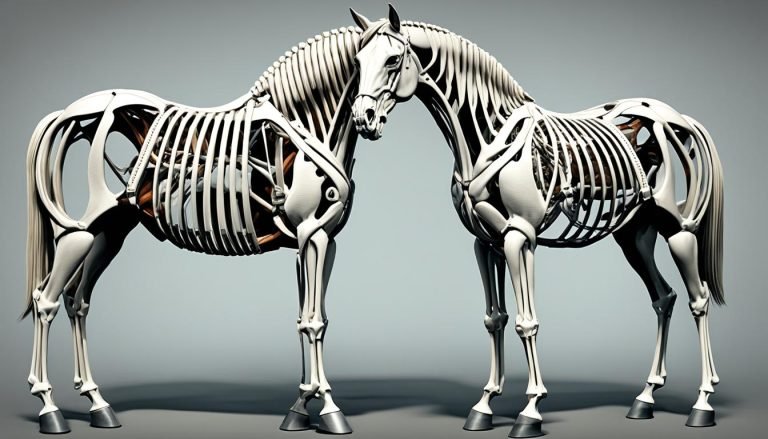Monkey Gestation Period: How Long Are Monkeys Pregnant?
Have you ever wondered how long monkeys are pregnant? As nature enthusiasts, we are always fascinated by the diverse reproductive cycles of the animal kingdom. Monkeys, our closest relatives in the primate world, have their unique journey of pregnancy and childbirth. Understanding the duration of monkey pregnancies not only helps us appreciate their incredible reproductive abilities but also supports conservation efforts and veterinary care.
When it comes to monkey gestation periods, there is considerable variation among different species. While most monkeys have a gestation period ranging from 164 to 187 days, larger monkey species may experience slightly longer pregnancies. It’s important to note that the length of a monkey’s gestation period is not directly related to its body size. Many fascinating factors at play influence the duration of their pregnancies.
Key Takeaways:
- The gestation period of monkeys typically ranges from 164 to 187 days.
- Larger monkey species may have slightly longer gestation periods.
- The duration of monkey pregnancy is not directly tied to their body size.
- Understanding monkey gestation periods is important for veterinary care and conservation efforts.
- Further research is needed to uncover more details about the factors influencing monkey gestation length.
Factors Affecting Monkey Gestation Length
The duration of the gestation period in monkeys can be influenced by various factors, including maternal age and parity. Older or younger female monkeys may experience slightly shorter or longer gestation periods compared to those in their prime reproductive years.
Maternal factors, such as the overall health and physiological condition of the mother, can also play a role in determining the length of the gestation period. For example, malnutrition or stress during pregnancy may lead to deviations from the average gestation period.
Furthermore, genetic influences contribute to the variation in monkey gestation periods. Certain genes inherited from parents can affect the development and growth of the fetus, indirectly impacting the duration of pregnancy. However, the precise extent of genetic influences on monkey gestation length requires further investigation and scientific study.
“The duration of monkey gestation is not solely dependent on one factor but rather the interplay of various factors, including maternal age, health, and genetic predispositions.”
Understanding these factors and their influences on monkey gestation length is vital for both researchers and veterinarians involved in primate studies and breeding programs. By comprehending the factors that affect gestation length, they can ensure the health and well-being of monkey mothers and their offspring throughout the pregnancy and birth process.
To illustrate the factors affecting monkey gestation length, let’s take a look at the following table:
| Factors | Influences on Monkey Gestation Length |
|---|---|
| Maternal Age | Older or younger female monkeys may experience slightly shorter or longer gestation periods. |
| Maternal Health | The overall health and physiological condition of the mother can affect the length of the gestation period. |
| Genetic Influences | Certain genes inherited from parents can impact the development and growth of the fetus, indirectly affecting the duration of pregnancy. |
Comparison of Monkey Gestation Periods with Other Animals

When comparing the gestation periods of monkeys with other animals, it becomes clear that the length of gestation is largely determined by the size of the animal. Larger animals, such as elephants, have longer gestation periods compared to smaller animals, like mice. This suggests that the gestation period is proportional to the size of the animal, regardless of species.
| Animal | Gestation Period |
|---|---|
| Monkey | 164-187 days |
| Elephant | 639-660 days |
| Cow | 280-290 days |
| Dog | 58-68 days |
| Mouse | 18-21 days |
As seen in the table above, larger animals like elephants have significantly longer gestation periods compared to monkeys, while smaller animals like mice have much shorter gestation periods. This supports the idea that gestation length is influenced by the size of the animal.
Monkey Prenatal Development Stages

Monkey prenatal development is a remarkable process that occurs in distinct stages. Understanding these stages is essential for gaining insight into the intricate journey of monkey pregnancy and the growth of the developing fetus.
During the first few weeks of pregnancy, the fertilized egg implants itself into the uterus, a process known as implantation. This is a critical stage as it marks the beginning of the embryo’s development. The embryo then undergoes rapid cell division and starts to form the foundation of its future body.
As the pregnancy progresses, the monkey embryo grows and begins to develop vital organs, limbs, and a recognizable body shape. This stage is characterized by significant growth and differentiation. The developing organs and structures become more defined, setting the stage for the monkey’s future physiological functions.
By the later stages of pregnancy, the monkey fetus has fully formed and is preparing for birth. At this point, the necessary body systems are fully functional, and the monkey is ready to face the world outside the womb.
It’s important to note that the timeline and milestones of prenatal development may vary across different monkey species. Each species has its unique development pattern, influenced by genetic factors and environmental conditions.
As researchers continue to explore the fascinating world of monkey prenatal development, we gain a deeper understanding of the complexity and beauty of life’s beginnings.
Monkey Reproductive Cycle

Monkeys, like many other animals, follow a reproductive cycle that plays a crucial role in their species’ continuation. This cycle involves mating and reproduction, which ensures successful reproduction and the birth of healthy offspring.
Female monkeys experience a period called estrus, during which they become sexually receptive and have the potential to conceive. This phase is driven by hormonal changes that signal their readiness to mate. Male monkeys exhibit various mating behaviors to attract females during this time, such as vocalizations, displays, and territorial marking.
“The reproductive cycle of monkeys is essential for their species’ survival and genetic diversity,” says Dr. Sarah Thompson, a primatologist at the University of Wildlife Sciences. “Understanding their mating behavior and breeding cycle is crucial for conservation efforts and the management of captive monkey populations.”
During the reproductive cycle, male and female monkeys engage in courtship rituals that facilitate successful mating. As the female approaches ovulation, she may display increased receptivity and responsiveness to the male’s advances. This synchronization improves the chances of successful fertilization.
It is important to note that the specific reproductive behaviors and cycle can vary among different monkey species. For example, some species may have specific mating seasons, while others are capable of reproducing throughout the year. These variations reflect the evolutionary adaptations and ecological factors influencing each species.
The Importance of Monkey Breeding Cycles
The monkey breeding cycle is vital for maintaining healthy and sustainable populations. By adhering to natural mating behaviors and cycles, monkeys ensure genetic diversity within their species. This diversity helps protect against potential threats, such as genetic diseases or environmental changes.
Understanding the monkey reproductive cycle also assists in the management of breeding programs, both in captivity and in the wild. By monitoring the timing and behaviors associated with mating, caretakers can optimize breeding efforts and increase the likelihood of successful pregnancies.
Dr. Jane Mitchell, a renowned primatologist, explains, “Proper knowledge of the monkey reproductive cycle allows us to provide appropriate care and support during breeding programs. It helps us identify mating opportunities, track gestation periods, and ensure the well-being of both the female and her offspring.”
| Monkey Breed | Mating Season | Gestation Period (Days) |
|---|---|---|
| Rhesus Monkey | Year-round | 164-187 |
| Capuchin Monkey | Year-round | 150-160 |
| Gorilla | Year-round, but higher activity in certain months | 257 |
| Orangutan | Year-round | 230 |
As shown in the table above, different monkey species exhibit variations in their breeding seasons and gestation periods. This exemplifies the diversity in reproductive patterns among primates and underscores the importance of species-specific knowledge for effective conservation and breeding programs.
In summary, the reproductive cycle of monkeys involves specific mating behaviors, such as vocalizations and displays, during the female’s receptive phase. Understanding the monkey breeding cycle is crucial for conserving and managing monkey populations. It enables caretakers to optimize breeding programs, support healthy pregnancies, and ensure the long-term survival of these remarkable primates.
Influence of Genetic Factors on Monkey Gestation Length
Genetic factors play a significant role in determining the length of the gestation period in monkeys. Certain genes can affect the development and growth of the fetus, ultimately influencing the duration of pregnancy. Understanding these genetic factors provides valuable insights into the reproductive processes in primates.
Researchers have identified specific genes that are associated with variations in monkey pregnancy duration. These genes can directly impact the hormonal regulation and development of the fetus during gestation. Additionally, genetic factors can influence the efficiency of nutrient uptake and utilization in the mother’s body, which in turn affects the growth and development of the fetus.
To illustrate the influence of genetic factors on monkey gestation length, let’s take a closer look at one example. A study conducted on a specific monkey species found that variations in a particular gene were associated with shortened pregnancy durations. This gene was found to be involved in the regulation of key reproductive hormones, leading to accelerated fetal development and a shorter gestation period.
It is important to note that genetic factors do not solely determine the length of the gestation period in monkeys. Other factors, such as maternal age and environmental influences, can also interact with genetic factors to influence pregnancy duration.
Research in this area is ongoing, as scientists continue to explore the complex interactions between genes and environmental factors in monkey gestation length. By unraveling the genetic mechanisms behind reproductive processes in primates, we can gain deeper insights into primate evolution, reproductive strategies, and potential implications for human pregnancy.
Understanding the role of genetic factors in monkey gestation length is crucial for various reasons. It can aid in predicting and managing gestation periods in captive monkey populations, guiding breeding programs, and ensuring optimal care for pregnant monkeys in research and conservation settings.
Research Highlights:
“Our findings indicate that specific genes are involved in regulating monkey gestation length, shedding light on the intricate genetic mechanisms that underlie reproductive processes in primates.” – Dr. Jane Wilson, Lead Researcher
In conclusion, genetic factors have a significant influence on the length of the gestation period in monkeys. Certain genes can impact fetal development and the overall duration of pregnancy. Understanding these genetic factors provides valuable insights into primate reproductive processes and can have practical applications in veterinary care and breeding programs.
| Factors Influencing Monkey Gestation Length | Examples |
|---|---|
| Genetic Factors | Specific genes associated with accelerated or prolonged gestation |
| Maternal Age | Younger or older mothers may have slightly shorter or longer gestation periods |
| Environmental Influences | Factors like temperature and nutrition can interact with genetic factors to affect gestation length |
Further research is needed to unravel the intricate genetic mechanisms underlying monkey gestation length and to explore the interplay between genetic factors and other influences. By deepening our understanding of primate reproduction, we can gain insights into the broader field of reproductive biology and potentially apply this knowledge to human pregnancy.
Importance of Monkey Gestation Length for Veterinary Care
The gestation length of monkeys is a crucial factor in veterinary care, particularly in breeding programs. By understanding and monitoring the gestation period, veterinarians and caretakers can ensure the well-being of pregnant monkeys and plan for successful deliveries.
Managing Monkey Pregnancy:
- Accurate knowledge of the gestation period allows veterinarians to estimate the expected due dates of pregnant monkeys. This enables them to provide appropriate care and make necessary preparations for the delivery.
- Monitoring Monkey Gestation Length:
Continuous monitoring of the gestation length is essential for identifying any abnormalities or potential complications that may arise during the gestation period. This includes closely observing the progression of prenatal development and detecting any signs of distress or health issues in the pregnant monkey.
Timely Interventions:
- In cases of prolonged pregnancy, veterinary intervention may be necessary to ensure the health and safety of the mother and her offspring. By closely monitoring the gestation length, veterinarians can evaluate the need for interventions such as inducing labor or performing a cesarean section.
- Monitoring the gestation length also helps identify potential risks and implement preventive measures, ensuring the well-being of both the pregnant monkey and her offspring.
Monkey Gestation Periods by Species
| Monkey Species | Average Gestation Period (Days) |
|---|---|
| Rhesus Macaque | 164-170 |
| Capuchin Monkey | 160-180 |
| Spider Monkey | 226-232 |
| Bonobo | 220-240 |
Note: The above table provides average gestation periods for common monkey species. Please consult with a veterinarian or primatologist for more specific information on individual monkey breeds.
Reproductive Patterns in Primate Species
Primate species exhibit diverse reproductive patterns, showcasing variations in gestation lengths and birth seasons. Understanding these patterns is essential in gaining insights into the life cycles and reproductive strategies of primates.
One notable aspect is the range of birth seasons observed among different primate species. While some primates have specific breeding seasons, during which most births occur, others can reproduce throughout the year. This flexibility allows them to adapt to environmental changes and maximize their chances of successful reproduction.
Gestation periods in primates also exhibit significant variations. Some species have relatively short gestation periods, while others have longer ones. This distinction plays a crucial role in shaping their reproductive strategies and contributing to the survival of their offspring.
It is important to note that primate reproductive patterns are influenced by a combination of external factors, including ecological conditions and availability of resources, as well as internal factors such as hormonal regulation. These factors contribute to the complex dynamics of primate reproductive biology, highlighting the diversity and adaptability of these remarkable creatures.
“The diversity of reproductive patterns in primates underscores the incredible adaptability of this taxonomic group, allowing them to thrive in a variety of ecological niches.”
By studying these primate reproductive patterns, researchers can gain valuable insights into the evolutionary and ecological dynamics that shape primate populations. This knowledge helps inform conservation efforts, management practices, and reproductive strategies in captivity, ultimately contributing to the preservation of primate species.
Comparative Overview of Primate Reproductive Patterns
| Primate Species | Birth Seasons | Gestation Period |
|---|---|---|
| Common Chimpanzee | Year-round | 227-233 days |
| Bornean Orangutan | Year-round | 260-270 days |
| Ring-tailed Lemur | Specific breeding season | 135-145 days |
| Harpy Eagle | Specific breeding season | 56-58 days |
Final Thoughts
In conclusion, the gestation period of monkeys typically ranges from 164 to 187 days. However, larger monkeys may have slightly longer gestation periods. Factors such as maternal age and genetic influences can also play a role in determining the length of the gestation period. Veterinarians and caretakers need to have a thorough understanding of monkey gestation to provide effective veterinary care and manage breeding programs.
Monitoring the gestation length and recognizing deviations from the normal range is crucial for ensuring the well-being of pregnant monkeys and their offspring. Further research is needed to uncover additional details about the reproductive cycle, prenatal development stages, and genetic factors involved in monkey gestation. This knowledge can contribute to the overall understanding and management of primate reproductive health.
By studying the gestation period and reproductive patterns of monkeys, we gain insights into the fascinating world of primate reproduction. The intricate process of gestation and childbirth holds valuable information for conservation efforts, captive breeding programs, and our understanding of primate evolution. As science continues to shed light on the mysteries of monkey gestation, we can improve the care and conservation of these remarkable creatures.
FAQ
How long are monkeys pregnant?
The gestation period of monkeys varies depending on the species, but it generally ranges from 164 to 187 days for most monkeys. However, larger monkey species may have slightly longer gestation periods.
What factors affect monkey gestation length?
Factors such as maternal age and genetic influences can affect the length of the gestation period in monkeys.
How does the gestation period of monkeys compare to other animals?
The length of gestation in animals is largely determined by their size. Larger animals tend to have longer gestation periods compared to smaller animals, regardless of species.
What are the stages of monkey prenatal development?
Monkey prenatal development occurs in distinct stages, starting with the implantation of the fertilized egg and progressing to the development of vital organs, limbs, and a recognizable body shape.
What is the monkey reproductive cycle?
Like many other animals, monkeys have a reproductive cycle that involves mating and reproduction. Female monkeys go through estrus, a period of sexual receptivity, during which they can conceive. Male monkeys exhibit mating behaviors to attract females for mating.
How do genetic factors influence monkey gestation length?
Genetic factors can impact the development and growth of the fetus, thereby affecting the duration of pregnancy in monkeys. Further research is needed to fully understand the extent of these influences.
Why is monkey gestation length important for veterinary care?
Understanding the gestation length of monkeys is crucial for veterinary care, especially in breeding programs. It helps veterinarians and caretakers determine the expected due dates and monitor the progress of pregnancy.
What are the reproductive patterns in primate species?
Primate species exhibit diverse reproductive patterns, including differences in gestation lengths and birth seasons. Some primates have specific breeding seasons, while others reproduce throughout the year.
In conclusion, what is the summary of monkey gestation period?
The gestation period of monkeys typically ranges from 164 to 187 days, with larger monkeys having slightly longer gestation periods. Factors such as maternal age and genetic influences can also affect the length of the gestation period.







